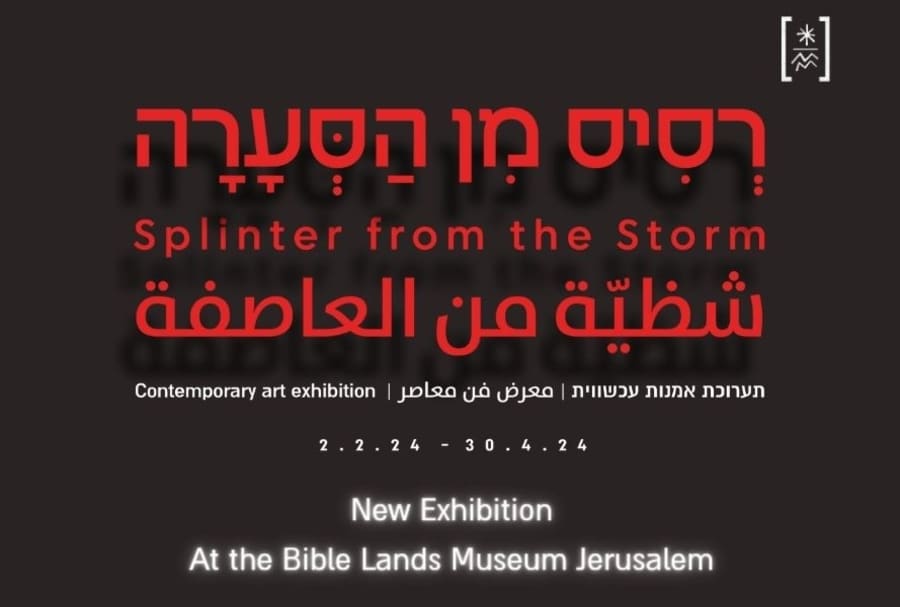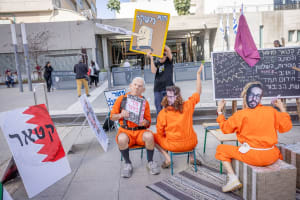INTERVIEW: The ‘power of art’ to heal - special Bible Lands Museum exhibit
‘Splinter from the Storm’ brought artists together after Oct. 7

A major Jerusalem tourist attraction currently epitomizes the unique Israeli and Jewish way of adapting in the face of adversity.
Since the 1980s, the Bible Lands Museum has been home to a collection of archaeology from the ancient Near East. Now, in the light of the Oct. 7 massacres, old and new creations have been put on display together, in a new exhibition entitled ‘Splinter from the Storm’.
“‘Splinter from the Storm’ is a little bit unexpected for us,” museum Executive Director, Dr. Risa Levitt, admitted during an interview with Christian journalist Paul Calvert of Bethlehem Voice.
The 38 contemporary pieces were mostly created around the time of Oct. 7, or immediately afterward, by a group of artists from Sam Spiegel Studios in Jerusalem. Some of the 20-plus artists are well known, while for others, it is the first time they are exhibiting their work outside of the gallery itself.
”We started a partnership with [the studios] very soon after the war broke out,” Levitt explained. “They brought their talents and creativity over to the museum, and we ran all kinds of special programs for evacuated families from the north and south for free, sort of like art and healing together.
“And from that grew this idea to bring their work into our museum and have contemporary art stand next to, I guess, what you would call ancient art, also depicting war and violence. And I think it creates a very interesting dialogue.”
The show was curated by Noah Arad and produced by Yael Boverman-Attas.
“You see 20 different voices of contemporary artists expressing their pain and their shock and their horror, alongside ancient artifacts that in some ways express the same thing. And it’s difficult and it’s moving and it’s emotional - and it’s very powerful,” Boverman-Attas told Calvert and described the feeling of utter shock throughout Israel, in the aftermath of the horrendous massacres perpetrated by thousands of rampaging terrorists.
“The first three days of the war, I was totally paralyzed. But then I had a very strong urge of, you know, survival. I tried to do something that is connected to what I do, so I connected with other artists in our studios, and we started offering [something] in three days.”
Like much of Israel, Boverman-Attas and her colleagues began doing whatever they felt they could do to help. The whole country was united in an instant, in the face of such atrocities, and long before the full extent of the massacres was reported or understood.
The group of artists launched a project, organizing art workshops for evacuees who were flooding Jerusalem by the thousands.
“We hosted, I think, 500 people in the first month, all voluntarily,” Boverman-Attas recalled. “We had people coming having left their home, three days before, with bodies in the backyard. They brought nothing with them. They came like completely shocked and lost and did art.
“And we actually, you know, we sank them [in] art. And when you feel the power of art and how it can heal and how people need it…”
Levitt said she felt the same urgency to take action.
“Like Yael said, at first we were all paralyzed. And then it became clear that something had to be done. And that was the beginning of our partnership, Yael having artists, and me having space, and watching the two sort of come together. And I think the exhibition is a result of that, very much.”
Half of the artists featured in the exhibition also conducted workshops for the evacuees.
Levitt told Calvert that the current war in Gaza has changed the way the museum operates.
“The museum has, for me anyway, completely changed,” said the relatively new executive director.
She explained that the normal procedure for protecting precious artifacts is to put everything away safely behind closed doors, especially during wartime.
“And yes, of course, we had to put everything away… but we have people to serve, we have a community to serve, and we opened our doors very quickly and we changed course."
"We ran programs here. We opened for free. We were approached by the Ministry of Education to provide space for an impromptu school, for special needs kids who were evacuated," Levitt continued.
“We did all kinds of things that you would never expect a museum of archaeology in Jerusalem to do, and I think it was really important for us to be a place of life, not just dead objects – a vehicle for change. And I think that’s a lot about what this exhibit is all about.”
The display includes landscape paintings by Boverman-Attas, who described the artistic journey she went through, from the trauma of hearing the cries for help, on 7 October, onwards:
“When I started off trying to react to the war… The first paintings were so shocking to myself that I had to erase them. It was like mother and son trying to hide in the bushes, stuff like that. Again, very biblical, if you think about Moses. But I could not even face it myself when I saw them, and I just washed them off the surface,” she told Calvert.
The artistic director explained that she moved to something more general, a little further from her personal view as a mother. The landscape, she said, is “everybody’s landscape.”
“The [paintings] are all very intense and, I would say, an expression of the feeling that I had during the war, which was the loss of the ground. It was really disastrous, the feeling of the open fields that we saw on TV the whole time that didn't feel safe anymore; [the] bombs were like coming down the sky like stars. It was very disturbing. And the deep feeling that you need to connect to the earth, that you need to stabilize yourself again, that’s what moved me.”
Boverman-Attas explained that two words came to mind to describe the exhibition more generally – "now" and "connect."
“We want everything to happen now,” she said. “We want the refugees back – now. We want the war to end – now… Because maybe there is not going to be tomorrow.”
‘Connect’ was “something that we had to do as artists,” she continued. “We had to connect to what we were feeling and bring it out. A lot of artists, usually, they just deal with their own stuff, but suddenly everybody’s reacting to what’s happening. It’s connecting everybody… and everybody wanted to participate – like, in no time! We put up the initial exhibition in two weeks. Everything is now and everybody wants to connect.”
Levitt described the way the layout of the exhibition is meant to reflect the feeling of the nation.
“We wanted it to be a little bit of a shock, let’s say. We didn’t want people to understand where exactly they would find contemporary pieces. So there’s no map; you just wander through the permanent gallery and stumble upon these pieces as they are, so to speak."
"Some of them are placed very intentionally in galleries where they seem to speak to the other objects, some of them a little less so, but the experience is a little bit disconcerting and somewhat shocking. And I think that speaks to everything that we've experienced over the last four months," Levitt said.
“Maybe I’m naive in thinking that by showing how much history repeats itself that maybe we can break the cycle. But that is my hope. Maybe this is a small drop in the bucket," she added.
“It’s probably the most important thing I’ve done in my museum career,” the museum director told Calvert. “And I hope I never have to do it again.”
The 'Splinter from the Storm' exhibit will run until the end of April. More information can be found here: www.blmj.org.
Click below to listen to the full interview.

The All Israel News Staff is a team of journalists in Israel.













